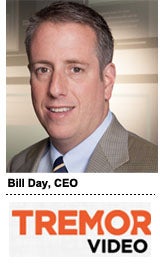 Like most of its video ad-tech rivals, Tremor Video has vied for TV-like brand dollars by offering a pitch based on online’s strength in performance with the branding appeal of “sight, sound and motion.” The problem, as Tremor’s Q3 earnings make clear, is that, as CEO Bill Day put it, TV buyers still value the “old-school” metrics of panel-based demographics.
Like most of its video ad-tech rivals, Tremor Video has vied for TV-like brand dollars by offering a pitch based on online’s strength in performance with the branding appeal of “sight, sound and motion.” The problem, as Tremor’s Q3 earnings make clear, is that, as CEO Bill Day put it, TV buyers still value the “old-school” metrics of panel-based demographics.
For the most part, Q3 showed Tremor’s recent avoidance of in-banner ads in favor of “brand-friendly” in-stream is good for sales. The company can only hope that that trend continues as it seeks to reduce losses.
Among the key results from Tremor’s Q3:
- Total revenue rose 17% over last year to $35.3 million.
- In-stream revenue gained 19% to $34.4 million.
- Gross margin was 40.3% compared to Q3 2012’s 44.6%.
- Mobile dollars comprised 9% of the Tremor’s total quarterly revenue in Q3 versus 7% for last year.
- Impression volume was up 29%.
- Net loss widened to $2.2 million from last year’s loss of $1.7 million. Read the earnings release.
Old-school: Among the stats shared with analysts during the earnings call, CFO Todd Sloan said effective CPMs declined by 5% due to buyers’ unwillingness to let go of demo pricing in favor of performance-based units. Recently, Tremor rolled out performance-based pricing that promises to directly match buying guarantees to advertisers’ benchmarks for engagement, perception, favorability, etc.
“Demo buying, which is typical in TV, requires that buyers pay only for ads that were delivered to a particular audience segment,” Day noted. “Unlike performance-based pricing models that rely on data that we generate, demo buying is old-school and currently allows for limited optimization that relies on panel-based data from third parties. The delivery of these campaigns resulted in lower eCPMs and a negative impact to our overall margins.”
Tremor will continue pushing advertisers to move past demos. To address buyer demand for demo buys while trying to insulate itself from the lower margins of that business, Day said Tremor will look at its optimization tools to better cover demographic targeting and work with data providers on improving the quality of their analytics.
Tremor has also released several pricing formats that offer guarantees based on proving whether or not a consumer’s favorability and intent for a brand was affected. Examples include the CPS unit (cost per brand shift) and CPQ (cost per conquest, where advertisers’ intent for a brand has shifted) as well as its Media Ratings Council accredited CPV&C (Cost-Per-100% Viewable & 100% Complete).
Marketplace moves: Second, in order to appeal to investors and advertisers who want to be sure that Tremor is not stuck in its traditional “network” model, Day said the company’s programmatic tools in the VideoHub Connect, which is essentially a video demand-side platform, is being tested by a number of marketers.
Day also outlined the work Tremor is doing to become a fuller marketplace for online video ads. He pointed to agreements with video-supply platforms such as SpotXchange and LiveRail. Those alignments are being complemented by its media network’s work with along with partnerships with other DSP operators, including Turn, MediaMath, IgnitionOne and Google’s DoubleClick BidManager under a project called “Tremor Extend.”
Day concluded the call saying that despite the demo-focused buying infrastructures that are built around media agencies’ TV operations, as consumption for online video grows, brand dollars will ultimately make the shift to performance metrics.
“It’s unrealistic to think that the buying habits ingrained in agencies over decades will get upgraded that quickly,” Day said. “And to be clear, I don’t think demographic targeting is going to go away. It’s just going to be a component of the buy and it will take time to evolve to reflect what we really do.”











